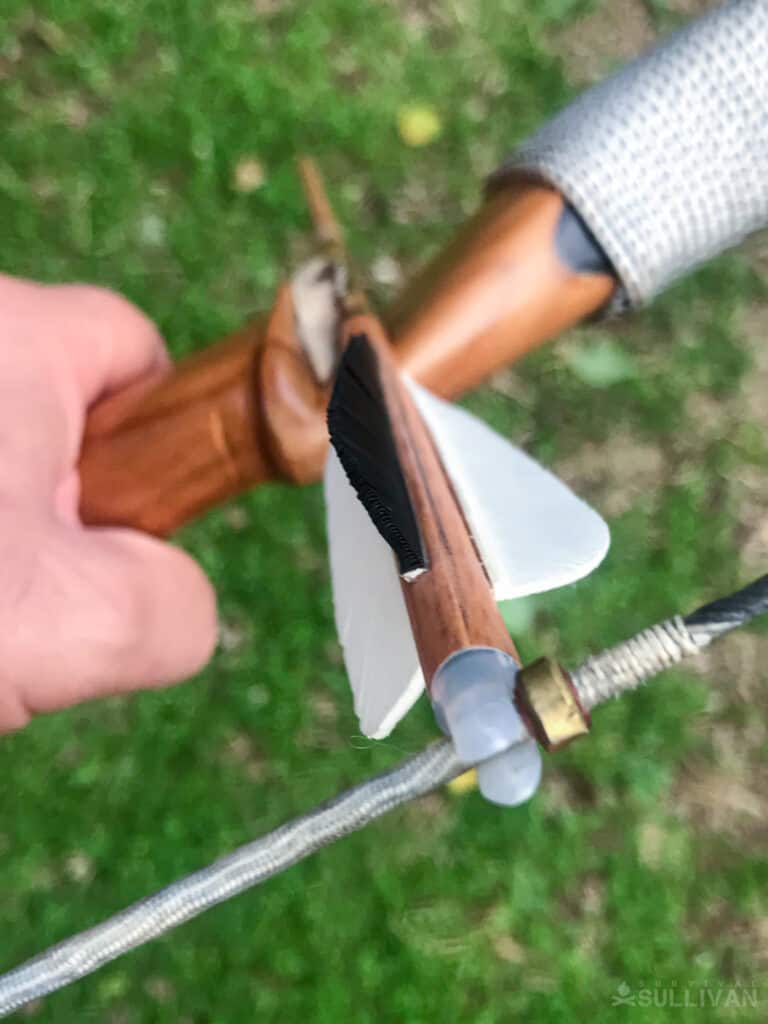One of the most important components of an arrow is the fletching. The style and material that make up this part of the arrow can determine its effectiveness and potential long-term durability.

The fletching is designed to keep the shaft of an arrow straight during flight by making it spin as it leaves the bow. Shooting an arrow without fletching is like having a vehicle with no steering capabilities.
Most bow owners are picky about the fletching they use on their arrows. This is mainly due to the large number of different types on the market.
Not all fletching is the same and there are reasons for using different types. Let’s start by taking a look at the different types of fletching.
What is Fletching?
For the arrow to fly true during flight the rear of the shaft needs to follow the front.
When an arrow leaves your bow it is seldom in line with the target, it leaves the bow at a slight angle instead.
The fletching corrects this angle and also reduces the archer’s paradox, where the shaft will flex after leaving the bow.
The average fletching size is between 2-5 inches with a profile that is a combination of length and surface area. There are multiple styles of fletching, each of which will have a unique effect on arrow flight.
There are a multitude of products on the market in regards to fletching which provides an extensive array of choices, but can be overwhelming to beginners.
In the end, it comes down to the preference of the archer and how durable of fletching you want.
Types of Fletching
There are two types of fletching for your arrows: feather and vanes. Both have their strengths and weaknesses and can be tailored toward different types of bowhunting.
1. Feather Fletching
The most traditional of fletching methods, it has been believed that feathers have been used for thousands of years and remain popular among bowhunters today.
Most traditional archers will shoot off the top of their hand and that’s why feather fletching is the only choice for them. As the arrow passes your hand (or the shelf) the feathers will flex and lay against the arrow.
In contrast, another type of fletching called vanes is more rigid and will tend to bounce off the shelf as it passes by.
You can get traditional feathers or synthetic ones, where the majority of them are made with turkey flight feathers. You’ll often find that the real feathers will last longer than the fake ones.
A traditional feather can be ruffled up from use but you can always smooth it out again whereas synthetic fletching can crack and not be the same again.
Additionally, feather fletching is generally longer than vanes which means they add stability to your arrows quickly.
For long-distance shooting, feather fletching can introduce drag and catch the wind, lowering accuracy.
During short distances and hunting, you won’t have to worry about wind drift and your shots.
2. Vane Fletching
If you’re looking for a durable, water-resistant option then go with a vane.
They are usually made with high-quality plastics that can be manipulated straight from the package to give you a straight or helical twist effect.
Feathers can only be twisted left or right without any helical turn. Hunters and target archers will use vanes as they are consistent in weight and size.
The vast array of sizes and shapes available dwarfs feather fletching, providing flexibility for different situations.
A vane is meant to help keep your arrows straight to ensure accurate shots.
There are different types of vanes but they can be broken down into major categories: high-profile and low-profile vanes.
High-profile vanes are meant to stabilize your broadhead arrows faster than low-profile vanes. They have a large surface area which makes them lose a bit of distance but the accuracy more than makes up for that loss.
Low profile vanes will affect the accuracy with slower stabilization but you’ll get faster speed and the arrow will be much quieter. A lot of bowhunters prefer using low-profile vanes for the silence they provide.
3. Straight Fletch
The most common type of fletching that manufacturers offer as already fletched arrows.
The fletch is straight with the arrow, meaning that there is minimal rotation which reduces accuracy. Little to no rotation means less drag and as such, you will gain a little more speed on the arrow.
4. Offset Fletch
An offset fletch has a slight turn from the front to the back. This is one of the most popular fletches for archers as it introduces the famous spin that is loved by the community.
As the arrow spins it stabilizes the arrow which steers it straighter. You’ll also notice less wind drag as the rotation makes it more aerodynamic.
5. Helical Fletch
A helical fletch will rotate the most without being a specialty vane, this is due to a more aggressive turn on the fletch. The accuracy with these kinds of arrows is incredible as the fast rotation keeps the shaft from wobbling.
If you’re looking at a helical fletch you can choose either a left or right-side orientation, with varying degrees of turning.
6. Spin Wings
Mainly used by competitive archers, spin wings are an aggressively turned fletch that provides great accuracy at the cost of speed.
You will not find these commonly used amongst bowhunters as they don’t work well with compound bows with heavy draws. They are delicate and susceptible to the elements which make them often need repair in those conditions.
Three or Four Fletches?
The amount of fletches isn’t as important as you might think it is. The idea behind four fletches is to improve arrow stabilization with a low-profile vane.
The added surface area increases wind resistance which helps to extend the distance traveled.
Pros and Cons of Different Fletching Types
With so many products on the market, choosing a fletching can be quite a big task, especially if you’re new to archery.
Check out the chart below for a quick overview of what the benefits and downsides are for each.
| Fletching Type | Pros | Cons |
|---|---|---|
| Straight Fletch | Faster travel speed than other types Great for short distances Water-resistant | Very little rotational spin Wind can easily pick it up |
| Offset Fletch | Causes the arrow to spin for better stabilization Can be used with fixed-blade broadhead arrows | Slower than other fletching styles Covers less distances |
| Helical Fletch | Very quick rotation and thus, stabilization Requires less bow tuning Provides maximum accuracy | Limited in range that it can travel The fletching method will catch a lot more wind since the bend is so steep |
Can You Shoot Arrows Without Fletching?
You can shoot a bow without fletching, however, it will fail or be incredibly inaccurate if you use any old bow.
Using a perfectly tuned bow with a highly experienced archer is one of the few situations where shooting straight without fletching is possible.
Tips on Maintaining Arrow Fletching
Having the feathers or vane of your arrow get damaged is detrimental for two reasons, your accuracy will be affected and any kind of separation can cause more drag.
In the case of your fletching coming off, the process should be fairly simple.
Tearing off the existing fletching, cleaning the area, and then replacing it with a new product is the best way to fix it.
Cutting corners will lower the integrity of the fletching, causing low performance in the field.
Final Thoughts
The important decisions to make here are whether to use feathers or vanes and to choose how you want to orient the fletching on your arrow.
The smaller the fletching the longer the distance it can travel, the larger the fletching, the shorter distance it can travel.
You will have to do some trial and error to find the right combination for your shooting style, but with all kinds of products out there, you will find one exactly for you.

Perrin is an adventure guide and naturalist currently living a nomadic life in the Canadian wilderness. His education and expertise is in wilderness survival and wildlife tracking. He enjoys teaching people about the outdoors and has managed large groups on expeditions.
With several accredited certifications, including being a wilderness first responder and a leave no trace expert, Perrin believes it is important for all of us to reconnect with the natural world.
